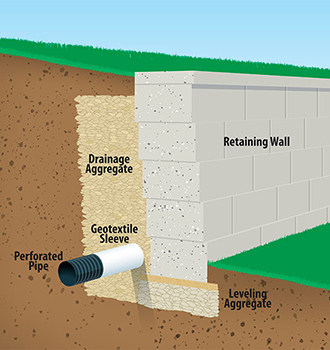Retaining Wall Perforated Drain Pipe

The pipe can be located just above the footing or can be located at a higher elevation.
Retaining wall perforated drain pipe. This drainage column allows water to migrate downward to the base of the wall. Taller walls may require more than one drain pipe to sufficiently relieve the hydrostatic pressure. This video shows you how to properly install a drainpipe behind your wall for prop. Pipe drains also known as toe drains are perforated pipes that collect water along the length of the wall and drain it to the outside.
Learning how to build a retaining wall can be fun with these helpful tips. Adding drains to the foundation of your retaining wall drainage is vital. Perforated drain pipe behind retaining wall. Perforated drains allow the water to flow out of the wall preventing it from collapsing under the weight of too much water.
Adding drainage pipe drain rock to retaining wall all access 510 701 4400 we are starting to add drain rock and sdr 35 drain pipe to our retaining wall located in benicia. Once the water makes it to the base of the wall it enters the perforated drain pipe. To help alleviate the surrounding grade concerns there is always a minimum 1 ft 0 3 m of clean stone behind the retaining wall that will handle mostly subsurface water. No perforated drain pipe.
Retaining walls as part of a landscape or garden are a very common occurrence. I hear arguments for both methods but it really depends on how the pipe functions in your drainage system before going any further the pipe we are discussing here is heavy duty. By doni anto february 18 2019. We always double.
Hi i m building a retaining wall in my garden a need to put a drain at the foot of the wall. This can be done by placing one pipe near mid height of the wall and another pipe near the footing of the wall. Steven baczek a residential architect from reading mass who specializes in designing durable low energy homes responds. When i use perforated pipe in a drainage system should the holes go up or down.
They are used in many areas from a foot or so high to tens of feet high they can be strictly for decorative purposes or they can be installed to hold back earth in order to level or grade a property as shown in figure 1.



























